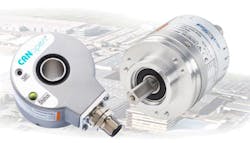Sensors: A First Step in Industrial Future Proofing
Last year, Automation World published a series of articles looking at how the Internet of Things (IoT) is changing automation technologies. From controllers and actuators to networks and sensors, we learned from technology suppliers and users how the IoT is affecting the evolution of industrial technology as well as how these devices are assessed, purchased and used.
This technological evolution is, of course, far from complete. In many cases, the process is just getting started. However, the path forward is becoming much clearer for manufacturers as suppliers are more open than ever about the direction in which they are taking their technologies. As an example of this Kübler, a supplier of sensors, motor feedback systems and process, safety and transmission technologies, highlighted how the IoT is affecting the development of its sensors at the most recent SPS/IPC/Drives event in Nuremberg, Germany.
Jonas Urlaub, product manager of system architecture at Kübler, said the driver behind Kübler’s expansion of its sensor capabilities are the demands of end users. Companies are expecting sensors to deliver more than the classical process data they have historically provided, he said. “For example, an encoder must not only provide speed and position, it must also be able to communicate its identity, its configuration, whether it detects errors and its environmental conditions.”
Explaining what it means for a sensor product—like an encoder—to be “IoT ready,” Urlaub said that, from a technical point of view, it is already possible to equip sensors with a web server or OPC UA interface, as Kübler has done with its new Industrial Ethernet encoders. Users are seeing an increasing number of such products, as the costs of making sensors “smart” has dramatically decreased over the past few years. But having the technological capability is just the first step in this evolution of automation, according to Urlaub. The existence of the technology at a competitive price point means that the next steps require planning and preparation by developers and users alike since few, if any, users would ever completely replace all their sensors at once.
“Basically, a developer [or user] should, whenever possible, prefer a sensor including a fieldbus interface or, better still, an industrial Ethernet interface,” said Urlaub. “For example, CANopen encoders are now at a cost level similar to that of standard SSI (synchronous serial interface) encoders.”
Urlaub added that, when selecting an encoder, developers and users should determine whether it is capable of providing data beyond historical encoder norms. For example, an encoder’s ability to provide data required for predictive maintenance concepts will help “future-proof” the plant, he said.
Users don’t need everything for industrial IoT today, Urlaub said. But it is important in preparing for the development of a smart factory that your sensors are able to receive software updates. “If not, this could have serious consequences—such as extremely high new procurement costs and dismounting and re-mounting costs for new sensors [that will] slow down industrial progress,” he said. “This is why Kübler implemented a boot loader function in its Sendix encoders. This allows for the loading of software updates via the customer interface to realize new functions.”
In addition to core information such as position and speed, Kübler's Sendix encoders, with their integrated diagnostic function, provide further information such as internal temperature monitoring. “The platform of the latest Kübler encoder generation [allows for] the possibility to connect further sensors and transmit prepared and packaged data to the controller via a single-cable interface, which substantially reduces wiring,” said Urlaub. “The platform will also allow for storage of further data for more comprehensive diagnostic concepts, such as for condition monitoring.”
Referencing Kübler’s use of OPC UA for cross-system communication (i.e., from machine to machine and from machine to the cloud), Urlaub notes the importance of the OPC UA’s enablement of encoder configuration via the Internet. “All Kübler industrial Ethernet encoders with a Profinet, EtherCAT or EtherNet/IP interface offer the possibility to integrate the OPC UA interface,” said Urlaub. “Both protocols are then provided via the same encoder connection. This furthers flexibility, as a simple switch will allow transmitting the data simultaneously to the controller and to the web server or into the cloud. Condition monitoring data such as the temperature, error messages, operating times and voltage supply are transmitted directly into the cloud. This allows simpler and faster realization of predictive maintenance approaches in new SCADA concepts.”
About the Author
David Greenfield, editor in chief
Editor in Chief

Leaders relevant to this article:
